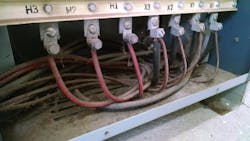The Case of the Incorrectly Tapped Transformer
While working at a sewage treatment facility, I ran across an interesting situation with a 30kVA transformer. I had bid on a replacement generator job and was given a set of drawings to work from, which included a detailed description of the existing equipment on-site and what should be included in the scope of work.
The information clearly stated that there was an existing 600A, 480/277V wye service fed from a pad-mounted electric utility transformer located outside of the building. The service conductors ran through underground conduits feeding a main disconnect switch that fed a transfer switch and a motor control center (MCC). Alongside the MCC was this little transformer that was labeled 480/208-120V. This transformer (as seen in the Photo), along with the MCC, had been installed in the early 1970s.Although some wiring had been added in a tangled mess, the equipment had never been cleaned, serviced, or tested. The transformer was being used to feed the 208/120V loads in the main building, including receptacles, lighting, and some motor loads.
As we were in the final stages of setting up the new transfer switch as called for on this project, a low-voltage alarm sounded, indicating that we weren’t getting the full 208V needed for the charger and block heater. Instead, the meter was reading about 194V phase-to-phase, and the phase-to-ground voltage was around 112V. On that day, the vice president of the company (an engineer) was in the room with me and was completely baffled by what had been discovered. Having dealt with this before, I knew exactly what the problem was.
I shut down and locked out the transformer, and then opened the case. Sure enough, I was reading 460V on the primary side. However, it was tapped for 480V. I changed the three taps to the 460V lugs, closed the case, and fired it back up. Now we had the correct secondary voltage of 208/120V.
The vice president was completely amazed at what I had done, and it went a long way in gaining his trust, which led to a lot more work. The amazing part of this story is that more than 45 years ago, an electrician tapped the transformer incorrectly, and for 4.5 decades nobody caught it. I can’t imagine how many devices and motors had their lives shortened by a chronic undervoltage condition.
Now retired after 40 years in the industry, John Kostick is a licensed master electrician in New Jersey and Delaware. He is also a licensed electrical instructor in New Jersey, a certified fire instructor, and a volunteer firefighter. He can be reached at [email protected]. Also read his recent articles, “A Pinch of Peril” and “Frightening Finds."
About the Author
John Kostick
Master Electrician
Kostick is a licensed master electrician in New Jersey and Delaware and has worked in the industry for 37 years. He is also a licensed electrical instructor in New Jersey and a certified fire instructor.

